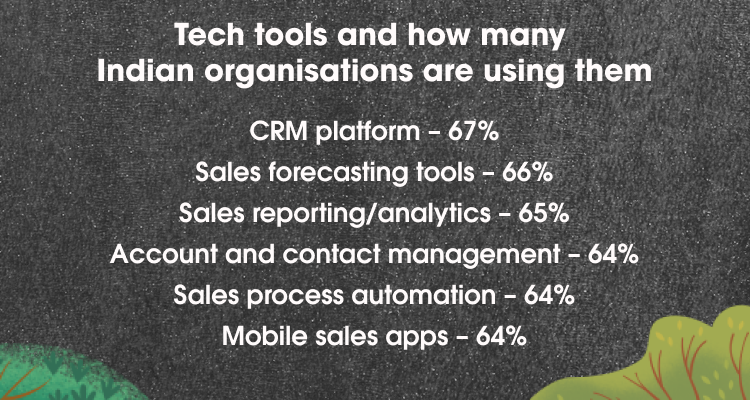As economic uncertainty shapes our immediate future, sales teams across industries are feeling the pressure to perform in challenging conditions. Supply chain issues, inflation, and buyer hesitancy are some hurdles sellers need to overcome, especially in a complex process like B2B selling.
With budgetary constraints and greater scrutiny of purchases across departments, the B2B sales cycle is lengthening, making it difficult for salespersons to close deals within a specific period. The fifth edition of the Salesforce State of Sales report details how sales professionals are adapting to such tough situations while striving to meet their targets.

However, it’s not a completely bleak scenario. Despite the changing dynamics of selling, most sales professionals vouch that sales promotion tools are helping them meet enhanced customer expectations and revenue goals in an efficient and cost-effective manner.
Top tools used by sales organisations in India
Investing in efficiency-boosting sales tools helps close more deals, improves customer experience, and enhances sales prediction and performance monitoring, highlights the report. The top tools preferred by sales professionals in India are

1. CRM platform
A Customer Relationship Management (CRM) platform offers a unified view of every customer’s omnichannel journey with the business. This enables sales teams to go beyond transactional relationships and create high-value, personalised customer engagements.
2. Sales forecasting tools
Intelligent sales forecasting tools offer a simplified view of the various factors impacting sales and revenue. In a slow sales environment, these can help sales professionals arrive at accurate targets and develop sales strategies as per evolving demand.
3. Sales reporting and analytics tools
Smart reporting and analytical tools enable sales professionals to glean insights from vast volumes of data, letting them understand what is and isn’t working for them. This lets them focus on critical accounts and identify areas for improvement, upselling, and cross-selling.
4. Sales process automation tools
Automating sales workflows removes unnecessary non-selling tasks from reps’ to-do lists. This diverts sales reps’ precious time and effort from low-value tasks to more strategic, revenue-generating activities. Leveraging sales automation tools also increases process efficiency, resulting in greater team productivity and enhanced CX.
5. Account and contact management tools
Account and contact management tools manage processes around different functions, locations, and touchpoints related to a single customer account in a comprehensive and effective manner. These leverage AI and analytics to enable reps to forecast and enhance account potential, generating greater revenue.
6. Mobile sales apps for employees
From strengthening sales pitches with data accessible in real-time, to quickly responding to customer inquiries, mobile sales apps help sales professionals drive better and more contextual customer engagement. Adding mobile apps to the sales mix lets sales teams access real-time updates and get an integrated view of customer profiles on the go.
There’s no doubt that sales tools such as these can boost efficiency and productivity. But how much is too much?
Sales teams in India use an average of 11 sales tools, as compared to the global average of 10
Despite their many benefits, juggling too many standalone tools can be a task. Learning and managing different user interfaces, click overload, and frequent training can cause confusion and burnout in an already stressed environment. Using multiple tools can also lead to data siloes, resulting in duplicated efforts and an inability to get a comprehensive view of the customer.
Globally, two-thirds of reps are overwhelmed by the sheer number of sales apps they are using
So how can organisations ensure more streamlined tool usage among sales reps?
How to do more with fewer sales tools
To reduce complexity and boost productivity, organisations must consolidate their sales tech stacks and also maximise the value derived from existing solutions. Here is how they can do so:
Streamline and modernise sales tech stack
Deploy one trusted platform like Salesforce Sales Cloud that integrates with internal and external systems, facilitates intelligence from across functions and channels and provides real-time insights into customer preferences and behaviour.
Modernising tools and technologies is a top growth strategy for Indian respondents in 2023,
says the report.
Boost CRM adoption
Indian respondents said that 73% of their time was spent in non-selling activities like administrative tasks and researching prospects: State of Sales report
Investing in an intelligent CRM and driving greater adoption among reps makes them aware of how to automate non-selling tasks and declutter their app ecosystem.
Improving training on tools and technologies is a top sales strategy for growth over the next 12 months
An all-in-one sales enablement tool is the key
A unified sales-specific CRM like Salesforce Sales Cloud can help organisations eliminate the need for multiple, expensive standalone tools. With features like AI-powered automation, Sales Cloud reduces complexity, maximises savings and increases the productivity of their sales teams, letting them close deals faster than ever before.
Reduce complexity and increase sales productivity with data-backed sales insights
Click here to download Salesforce State of Sales Report































